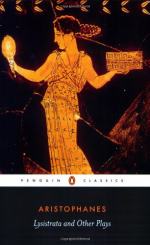|
This section contains 304 words (approx. 1 page at 400 words per page) |

|
Lysistrata Summary & Study Guide Description
Lysistrata Summary & Study Guide includes comprehensive information and analysis to help you understand the book. This study guide contains the following sections:
This detailed literature summary also contains Bibliography and a Free Quiz on Lysistrata by Aristophanes.
Lysistrata is often produced in contemporary theatre. Modern audiences enjoy the sexuality and humor in Aristophanes' work, and they enjoy what appears as modern feminism and the depiction of strong women. Comedies were very popular presentations during the Greek festivals, and there is no reason to think that Lysistrata was not immensely popular. At the time of the play's initial production, Athens and Sparta had been at war for twenty years, and this play would have offered one of the few opportunities to laugh at war. The idea that Lysistrata could unite women to end the war would have set up the audience for a traditional battle between the sexes. However, there are also serious ideas to be found in Lysistrata's speeches. She reminds the audiences of the many men who have died during the Peloponnesian War, and the Chorus of Old Men emphasizes that there are no young men to take up their position. Aristophanes uses a woman to bring peace, but in doing so, he is pointing out to men that they have failed in their efforts to settle the war. With the failure of men, women are the only remaining hope for peace. There is no record that Aristophanes received any awards for Lysistrata, but the play's popularity in modern productions points to its probable success on stage. In 1930, Lysistrata enjoyed a successful revival in New York City, which lasted for several months. It has inspired an opera, Lysistrata and the War, which was written in the early 1960s and first performed by the Wayne State University opera workshop, as a protest to the Vietnam War. The theme of war and women's efforts to invoke love as a replacement for war works as well in the twenty first century as they did in the late fifth century B.C.
Read more from the Study Guide
|
This section contains 304 words (approx. 1 page at 400 words per page) |

|



